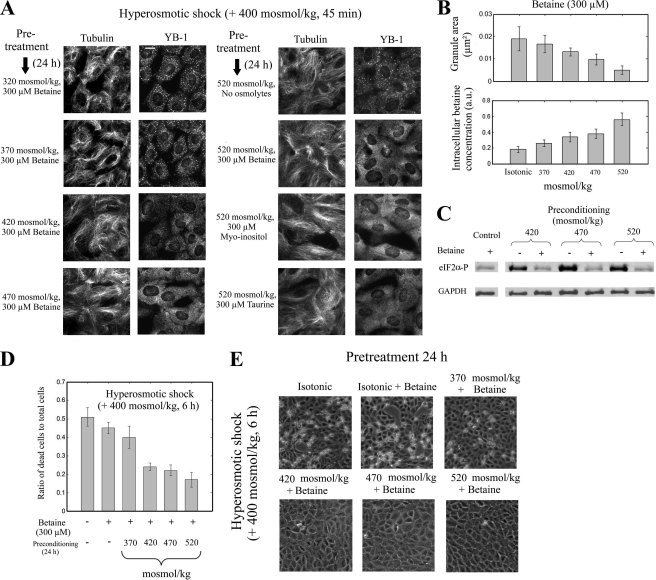FIGURE 6.
Hypertonic preconditioning inhibits SG assembly and promotes cell survival. A, NRK cells were pretreated for 24 h as indicated. Then, NaCl osmotic shock was applied for 45 min by increasing the osmolality by 400 mosmol/kg with respect to the osmolality of the pretreatment medium. In the first column, we observed that increasing the osmolality of the pretreatment in the presence of betaine leads to the progressive impairment of SG assembly. In the second column, we observed that not only betaine but also myo-inositol and taurine can also impair SG assembly. These same remarks are also valid for the impairment of MT bundling. SGs and MTs were detected with anti-YB1 and anti-tubulin immunostaining. Scale bar, 10 μm. B, statistical analysis of the SG areas obtained from A and NMR measurement of the betaine accumulation in cells after 24 h of hypertonicity is shown. As expected, the magnitude of the intracellular betaine accumulation is dictated by the extracellular osmolality, and there is a negative correlation between the SG size and the amount of intracellular betaine. Results are the mean ± S.D. (1 a.u. corresponds to 72 fmol of betaine per NRK cell). C, Western blotting of cells extracts from preconditioned NRK cells exposed to an increase of osmolality (+400 mosmol/kg) for 45 min is shown. The phosphorylation of the initiation factor eIF2α is significantly reduced for cells preconditioned in the presence of betaine (10 mm). Control, NRK cells under isotonic condition with 10 mm betaine without hypertonic shock. GAPDH was used as a loading control. D, shown is the rate of cell death after hypertonic shock (+400 mosmol/kg for 6 h) applied to preconditioned NRK cells as determined via trypan blue exclusion. Cell preconditioning under hypertonic environment in the presence of betaine (300 μm) promotes cell resistance to hypertonic aggression. E, shown is phase contrast optical microscopy of NRK cells preconditioned as indicated and exposed to a hypertonic shock (+400 mosmol/kg for 6 h). We observed that without hypertonic preconditioning the integrity of the epithelia was affected, and many cells were detached, in contrast to preconditioned epithelia, which were protected from these damages. Together, these results confirm that hypertonic preconditioning in the presence of betaine promotes cell resistance to hyperosmolarity. See also supplemental Fig. S7 for the effects of other extracellular compatible osmolytes (taurine and myo-inositol).

